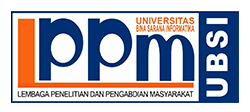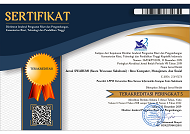PENERAPAN ALGORITMA NAÏVE BAYES UNTUK PENENTUAN CALON PENERIMA BEASISWA PADA SMK PASIM PLUS SUKABUMI
Abstract
Full Text:
PDF (Bahasa Indonesia)References
Aditya, A. N. (2011). Jago PHP & MySQL. Bekasi: Dunia Komputer.
Azis, S. (2013). Gampang & Gratis Membuat Website:Untuk Web Personal. Jakarta Pusat: Kunci Komunikasi.
Dika, H. (2015). Kajian Perancangan Rule Kenaikan Gaji Pada PT. ABC . Simetris, 219.
Ellitan, L., & Anatan, L. (2007). Sistem Informasi Manajemen: Konsep dan Praktis. Bandung: Alfabeta, CV.
Gunawan, Kesuma, R. P., & Wigati, R. R. (2013). Pengembangan Sistem Penunjang Keputusan Penentuan Pemberian Beasiswa Tingkat Sekolah. JSM STMIK Mikroskil.
MADCOMS. (2009). Adobe Dreamweaver CS4. Yogyakarta: Penerbit ANDI. Priyadharsini, C., & Thanamani, A. S.(2014). An Overview of Knowledge Discovery Database and Data Mining Technique. IJIRCCE, 1572., 2012.
Putra, A., & Hardiyanti, D. Y. (2011).Penentuan Penerima Beasiswa DenganMenggunakan FuzzyMultiple AtributeDecission Making. JSI, 287.2009.
Rosa, S. A., & Shalahudin, M. (2013).Rekayasa Perangkat Lunak.Bandung: Informatika.
Saleh, A. (2015). Implementasi MetodeKlasifikasi Naïve Bayes Dalam Memprediksi Besarnya Penggunaan ListrikRumah Tangga. Citec Journal, 209.
Saputra, R. A. (2014). Penerapan AlgoritmaNaive Bayes Untuk Prediksi PenyakitTuberculosis. Swabumi, 19.
Sihotang, F. (2013). Sistem PendukungKeputusan Penerima BeasiswaDengan Metode TOPSIS.Pelita Informatika Budi Darma, 6.
Swastika, W. (2006). PHP 5 & MySQL 4.Jakarta: Dian Rakyat.
Syahrizal, M. (2012). Perancangan Sistem Aplikasi Pembuatan Roster Mata KuliahPada Perguruan Tinggi.
Wajhillah, R. (2015). Optimasi Algoritma Klasifikasi C4.5 Berbasis Particle Swarm Optimization UntukPrediksi Penyakit Jantung. Swabumi, 27.
Wasiati, H., & Wijayanti, D. (2014).Sistem Pendukung Keputusan PenentuanKelayakan Calon Tenaga Kerja IndonesiaMenggunakan Naive Bayes. IJNS, 45.
Widodo, P. P., & Herlawati. (2011).Menggunakan UML. Bandung:Informatika. Widodo, P. P., Handayanto, R. T., &Herlawati. (2013). Penerapan Data MiningDengan Matlab. Bandung: Rekayasa Sains.
Yakub. (2008). Sistem Basis Data TutorialKonseptual. Yogyakarta: Graha Ilmu.
DOI: https://doi.org/10.31294/swabumi.v4i2.5401
INDEXING

P-ISSN : 2355-990X E-ISSN: 2549-5178














